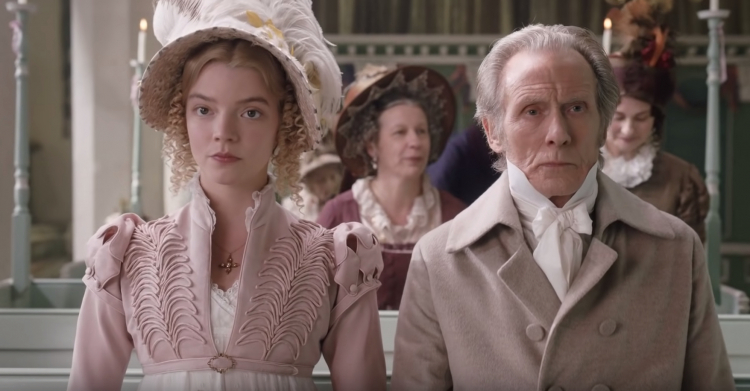Emma.: A Breath of Fresh Air for Jane Austen’s Iconic Satire

Following Amy Heckerling’s 1995 cult classic Clueless, Douglas McGrath’s 1996 film, Emma, and a 1996 made-for-TV film version of the story, one might think that filmmakers would have retired the story of Emma Woodhouse by the end of the century. In Autumn de Wilde’s adaptation of the story, Emma., we follow the story of Emma Woodhouse, described by Austen as “handsome, clever, and rich”, and the mishaps of meddling in her friends’ romantic lives. The film stars Anya Taylor-Joy as Emma Woodhouse (who you might recognize from the A24-produced film The VVitch, or from Split, alongside James McAvoy) as well as Bill Nighy, Mia Goth, and Johnny Flynn. It’s easy to feel like period pieces are a little too far away from us to feel relatable, but Emma. finds a way to feel fresh, funny, and relevant even to a contemporary audience.
Autumn de Wilde is most known for her work photographing and directing music videos and documentaries for musicians like Fiona Apple, The White Stripes, and Sonic Youth. Although this is her debut feature length film, she approaches the film like a pro with a bold and confident vision, and it pays off. A pastel color palette doesn’t feel overly Wes Anderson-esque, and cinematography (Christopher Blauvelt), costume design (Alexandra Byrne), and production design (Kave Quinn) work so in tune with each other that I felt like the characters were going to burst into song and dance at any given moment. The film takes the best parts of seeing a stage production and translates them seamlessly into a visually stunning film. Symmetrically-focused shots and little to no camera movement, just to name a few, contribute to the film’s feeling of a stage production, and lend themselves to a more unique viewing experience. By allowing us to notice the grandeur of the Woodhouse home, or the precise details on the characters’ clothing, the film pushes what Jane Austen originally meant for her novel to be: a satire depicting issues not only of love and age, but of social status.
Image Credit: Focus FeaturesThe film’s odd punctuation stems from a joke. Autumn de Wilde explained that “There’s a period at the end of Emma because it’s a period film!”. The subtlety of this clever joke foreshadows the clever humor and charm which characterize the film. It can definitely be a challenge to make 19th century England feel fresh and relatable to a modern audience, but with a meticulous eye for detail, de Wilde does just that. By placing an emphasis on her characters she makes each one seem like someone you’ve already met. Emma Woodhouse feels closer to audiences than ever before, and we feel as though we’re in on her jokes with Harriet Smith (Mia Goth) instead of just acting as bystanders in an unfamiliar environment. Jokes set up at the beginning of the film are built upon as the film progresses (Bill Nighy as Mr. Woodhouse, the ultimate on-screen dad, comically complains about a chilly draft in nearly each scene), another way we feel more at home in the setting than we might predict.
What is most striking about Emma. is its relatability. Even through a stage-production feel and characters we might never fully identify with, the situations never feel too far away from us. Whether it be your 20s and thinking you know everything there is to know, or just drinking a little too much at a party, the film hits close to home when it comes to love and all its complications. Perhaps the film resonates with so many of us today because it’s comforting to see that even since Jane Austen’s time, love has and always will be delicate, confusing, but worthwhile.








